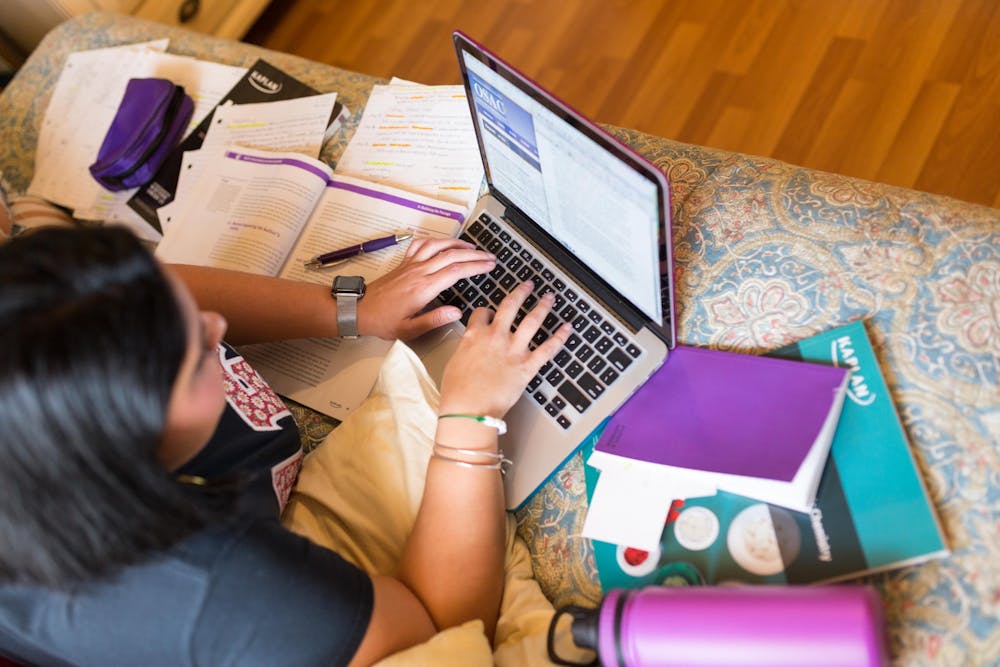The Association of American Medical Colleges offers a Fee Assistance Program to help students address potential financial barriers in the application process. Hernandez said while fee assistance did lower the price of the MCAT and provide some study resources, he took out a $1,000 loan to pay for books.
He said as a student of lower socioeconomic status, these additional costs are constantly in the back of his mind.
“It pervades every thought throughout med school of when you see that stethoscope and you’re like, ‘Damn, you know, that’s a lot of money,’ those kinds of things,” he said.
According to the Office of Financial Aid & Scholarships, the cost of attendance per year at UNC School of Medicine is $70,920 for in-state students and $98,314 for out-of-state students. The "cost of education", or COE, takes into account expenses for items like school supplies, transportation and room and board.
Like Hernandez, first-year UNC medical student Noelani Ho believes the financial burden of attending medical school begins in the application process. She co-authored an article on the issue, which was published in October in the New England Journal of Medicine. Ho said the cost of applying can be daunting, and acts as a barrier to increasing diversity in the profession.
“Our argument there was like, it's great that we're starting this conversation about free tuition, we definitely think that’s the direction we need to be going in and it's definitely helping the cause,” Ho said. “But we also need to address the fact that the pool of applicants that medical schools are picking to give this free tuition to, is in and of itself not as diverse as it needs to be, both in terms of race and socioeconomic status.”
Addressing education debt
Admissions officers at 70 medical schools in the U.S. and Canada were surveyed in a separate Kaplan poll, in which only 4 percent of officers said they believed their institution would be able to offer free tuition in the next decade.
Jeff Koetje, Kaplan Test Prep’s director of pre-health programs, said moving toward tuition-free options involves a number of factors.
"What is within the realm of possibility for a school is going to depend on what is that mix of sources of funds that are currently available to the school to support its operations, and tuition is a pretty significant aspect of that,” Koetje said. “The elimination of tuition or the reduction in tuition coming into the school means that the school really needs to think about how is it going to make up that loss of that particular source of funds.”
UNC School of Medicine currently offers a number of scholarships and financial aid to its students, although the majority of awards are loans. 78 percent of UNC medical school students received scholarships, according to 2017-2018 data from the Liaison Committee on Medical Education.
Beat Steiner, senior associate dean for medical student education, said UNC School of Medicine supports trying to find ways to reduce tuition burden for students.
To get the day's news and headlines in your inbox each morning, sign up for our email newsletters.
“I think it's important to note that we’re a state-sponsored school, right, so we’re a state medical school,” Steiner said. “And if it was the will of the citizens of North Carolina to go in the direction of tuition free, that would be just wonderful.”
Steiner said two-thirds of UNC’s cost of education is paid for by student tuition, while the remaining one-third is funded by state and donor support to the School of Medicine. He said one way the school tries to reach students of underrepresented backgrounds is by encouraging professional development in state high schools.
Obstacles for free tuition
Julie Byerley is the vice dean for academic affairs in the UNC School of Medicine. She said although she supports lowering students’ debt, she has also heard the argument that it’s unfair to single out education debt in medicine given the number of other valuable professions in the United States. But she also said one reason medical education may be more costly is because it happens in “an apprenticeship sort of way,” and is therefore expensive to carry out.
She also said increasing tuition-free options could lead to a potential devaluation of initiatives that incentivize students to go into needed areas of medicine, like the Kenan Primary Care Medical Scholars Program. The program offers financial support and opportunities to students pursuing careers in rural medicine and primary care.
Ariel Harris, a first-year in UNC’s School of Medicine and first-generation college student, said when she was applying to UNC, the school placed a lot of emphasis on going into primary care.
Harris said she received a $20,000 scholarship for medical school, but like Hernandez, she had to take out loans to cover the other parts of the cost of education. Both Harris and Hernandez said despite the benefits of the fee assistance program, the costs of applying limited the schools they chose to apply to.
Ho said perhaps one way to level the playing field for prospective medical school students is for the Association of American Medical Colleges to place a cap on the number of schools students can apply to or for schools to encourage more virtual interviews to cut down on travel costs.
Harris said she hopes medical schools can be more transparent about costs, particularly at events like pre-health fairs for undergraduate students.
“They talk about all the great things that come with their school, but then you see this really big price tag, and then people kind of shy away,” Harris said.




